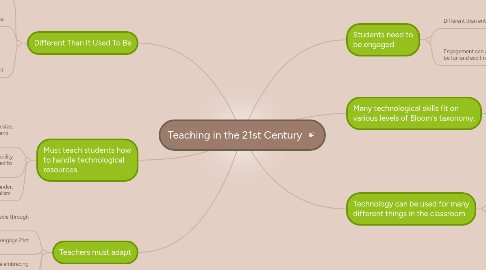
1. Different Than It Used To Be
1.1. Students can now find information on anything, anytime, anywhere.
1.1.1. Blogs, Facebook, cell phones, Twitter, Wikipedia, Google, etc
1.2. Teachers must now do more than provide content, facts, information, etc. if they do not want to be obsolete
1.2.1. We are no longer the main source of information; we are the filter
1.3. The tools teachers use are different
1.3.1. No longer just papers, pencils, notebooks, etc
1.3.2. Cellphones, computers and iPods are now used regularly by students
1.3.3. However, no matter what the tools, there is always temptation. Which is why teachers have to provide engaging lessons for students.
2. Students need to be engaged
2.1. Different than entertainment
2.1.1. Entertainment is passive, for enjoyment, short-lived, doesn’t require relevance, allows escape from problems, and uses the creativity of others
2.2. Engagement can and should be fun and exciting
2.2.1. Engagement is active, is for learning, has long-term results, is meaningful and applicable, is solving problems,and is using the creativity of the participant
3. Must teach students how to handle technological resources
3.1. They need to know how to validate, synthesize, leverage, communicate, collaborate with, and problem solve with information
3.2. Responsibility, reliability and integrity all need to be taught
3.2.1. It is better to learn this from teachers than strangers, friends or even themselves
3.3. We must help students learn about pirating, plagiarism, slander, copyright, crowdsourcing, confidentiality, and professionalism
4. Many technological skills fit on various levels of Bloom's taxonomy.
4.1. Creation, the highest level on Bloom's revised taxonomy, is extremely important in today's classroom.
4.1.1. Blogging, podcasting, animating, planning, recording, designing, programming all involve students in the creative process
4.2. Paraphrasing, attributing, editing, experimenting, reflecting, commenting, searching, locating, integrating, networking, bookmarking,and uploading are also important skills
5. Technology can be used for many different things in the classroom
5.1. Gathering and discussing data
5.1.1. Via cellphone, Twitter, Facebook, online surveys, etc
5.2. Talking about reliable sources
5.2.1. Via Google, Wikipedia, blogs, podcasts, etc
5.3. Publishing and evaluating students' work
5.3.1. Via websites, wikis, video and audio programs, etc
5.4. Collaboration
5.4.1. Via Skype, Twitter, Facebook, etc
5.5. To help struggling students
5.5.1. Via Wordles, virtual manipulatives, graphic organizers, etc
